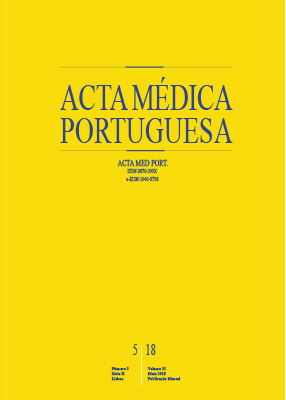2017 Census: are there enough anaesthesiologists in Portugal?
DOI:
https://doi.org/10.20344/amp.10094Keywords:
Anesthesiology/manpower, Anesthesiologists, PortugalAbstract
Introduction: The objective of this study is to identify the number of anaesthesiologists working in Portugal and to monitor the national activity of this medical specialty by comparing it with a similar Census performed in 2014.
Material and Methods: Observational cross-sectional study. Data related to the month of May 2017 was collected from Anaesthesiology departments of 53 Portuguese public institutions from a total of 86 hospitals.
Results: The Census registered 615 127 surgical procedures (3.4% more than in 2013), 84.1% of which on a non-emergent basis, and 49.6% day case surgery (6.1% more than in 2013). Moreover, 89 608 procedures were performed outside the operating rooms (19.0% less than in 2013), 282 944 were anaesthetic clinics (1.3% more than in 2013) and 112 183 were chronic pain evaluations (13.1% more than in 2013). In addition, 51 380 labour analgesia were performed for delivery (14.3% more than in 2013) corresponding to 70.5% of all deliveries occurring in the Obstetric department of Portuguese public hospitals in 2016 (5% more than in 2013). A total of 1280 Anaesthesiologists were identified (2.1% more than in May 2014), corresponding to a ratio of 12.4 per 100 000 inhabitants (it was 12.0 in May 2014). Together with the 262 anaesthesiologists that work exclusively in the private system, we found a total sum of 1542 anaesthesiologists indicating a ratio of 15.1 per 100 000 inhabitants (it was 13.9 in 2014).
Discussion: We predict that the identified deficit of 541 anaesthesiologists in the Portuguese National Health Service should be
reduced by two thirds until 2023. The reduction of the shortage of anaesthesiologists will allow an increase in human resource capacity in Anaesthesiology.
Conclusion: Even though there was a slight increase in the ratio of Anaesthesiologists per inhabitant in 2017 compared to 2014, Portugal maintains a shortage of Anaesthesiologists.
Downloads
Downloads
Published
How to Cite
Issue
Section
License
All the articles published in the AMP are open access and comply with the requirements of funding agencies or academic institutions. The AMP is governed by the terms of the Creative Commons ‘Attribution – Non-Commercial Use - (CC-BY-NC)’ license, regarding the use by third parties.
It is the author’s responsibility to obtain approval for the reproduction of figures, tables, etc. from other publications.
Upon acceptance of an article for publication, the authors will be asked to complete the ICMJE “Copyright Liability and Copyright Sharing Statement “(http://www.actamedicaportuguesa.com/info/AMP-NormasPublicacao.pdf) and the “Declaration of Potential Conflicts of Interest” (http:// www.icmje.org/conflicts-of-interest). An e-mail will be sent to the corresponding author to acknowledge receipt of the manuscript.
After publication, the authors are authorised to make their articles available in repositories of their institutions of origin, as long as they always mention where they were published and according to the Creative Commons license.









